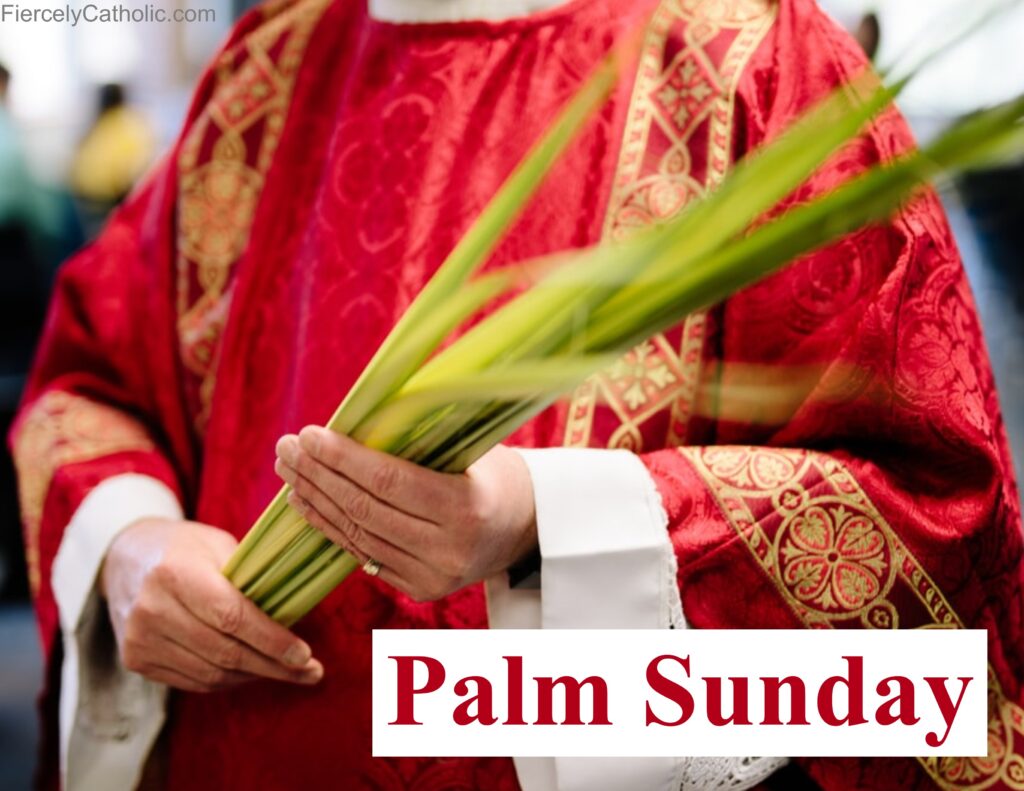
Throughout Holy Week, the final week of Lent, Catholics pray and reflect on the events leading up to and during the Passion, Death, and Resurrection of Jesus.
The holiest week of the year begins on Palm Sunday, one week before Easter Sunday. Palm Sunday is also called Passion Sunday.
On Palm Sunday, the liturgy focuses on both the joyful and sorrowful aspects of Jesus Paschal Mystery.
Solemn processions and the blessing and distribution of palm branches call to mind Jesus responding the the people crying out for help as he makes his triumphant entry ino Jerusalem where He will make his sacrifice.
The readings at Mass include a Passion narrative from one of the Gospels which recount Jesus’ inauguration of a new Passover which ends with his suffering and death on the Cross. Catholics participate in the readings out loud as a reminder that Jesus’ passion and death is the price that He paid for their sins.
A week set apart:
The holiest time of the year:
A journey from false triumph to true triumph:
All of Jesus’ emotions as He prepared for His struggle:
On the next day, when the great crowd that had come to the feast heard that Jesus was coming to Jerusalem, they took palm branches and went out to meet Him, and cried out: “Hosanna! Blessed is he who comes in the name of the Lord, [even] the king of Israel.” Jesus found an ass and sat upon it, as is written: “Fear no more, O daughter Zion; see, your king comes, seated upon an ass’s colt.” His disciples did not understand this at first, but when Jesus had been glorified they remembered that these things were written about Him and that they had done this for Him.
John 12: 12-16
Celebrating Palm Sunday around the world:
How will Jerusalem welcome her Messiah? Although Jesus had always refused popular attempts to make Him king, He chooses the time and prepares the details for his messianic entry into the city of “his father David”. Acclaimed as Son of David, as the One who brings salvation (Hosanna means “Save!” or “Give salvation!”), the “King of glory” enters his City “riding on an ass”. Jesus conquers the Daughter of Zion, a figure of his Church, neither by ruse nor by violence, but by the humility that bears witness to the truth. And so the subjects of his kingdom on that day are children and God’s poor, who acclaim Him as had the angels when they announced him to the shepherds. Their acclamation, “Blessed be He who comes in the name of the Lord”, is taken up by the Church in the “Sanctus” of the Eucharistic liturgy that introduces the memorial of the Lord’s Passover.
Catechism of the Catholic Church 559
A sign of victory for a humble King:
God responds to our cry for help:
Welcoming the King and Messiah with branches and shouting:
The celebration of Holy Week begins with the “Hosanna!” of Palm Sunday and culminates in the “Crucify Him!” of Good Friday. But this is not a contradiction; rather it is the heart of the mystery the liturgy wants to proclaim: Jesus willingly gave Himself up to his passion; He did not find Himself crushed by superior forces. It was He himself who, in discerning the Father’s will, understood that his hour had come and He accepted it with the free obedience of the Son and with infinite love for mankind.
Pope John Paul II, Homily, 28 March 1999
Jesus’ words and actions at the climax of his life:
Jesus’s love persisted through betrayal and crucifixion:
The readings for Palm Sunday are long for a reason:
The Truth, Goodness, and Beauty of the Catholic Church
Our job is to serve the Lord:
Share this page with friends and family to start a conversation about your faith.
Don’t miss a post. Learn more about the Catholic Church and strengthen your Catholic faith.
Find more Fiercely Catholic video issues here.
Subscribe here.


